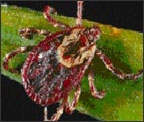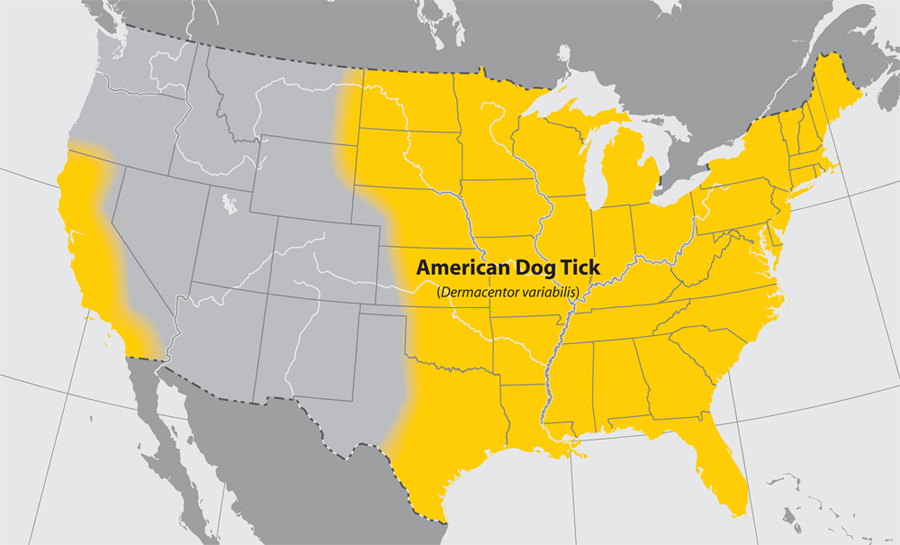Dermacentor variabilis: Difference between revisions
Jump to navigation
Jump to search
No edit summary |
No edit summary |
||
| Line 21: | Line 21: | ||
'''''Dermacentor variabilis''''', also known as the '''American dog tick''' or '''Wood tick''', is a species of [[tick]] that is known to carry [[bacteria]] responsible for several diseases in humans, including [[Rocky Mountain spotted fever]] and [[tularemia]] (''Francisella tularensis''). It is one of the most well-known [[hard tick]]s. Diseases are spread when it sucks blood from the host, which could take several days for the host to experience some symptoms. | '''''Dermacentor variabilis''''', also known as the '''American dog tick''' or '''Wood tick''', is a species of [[tick]] that is known to carry [[bacteria]] responsible for several diseases in humans, including [[Rocky Mountain spotted fever]] and [[tularemia]] (''Francisella tularensis''). It is one of the most well-known [[hard tick]]s. Diseases are spread when it sucks blood from the host, which could take several days for the host to experience some symptoms. | ||
==Transmitted Diseases== | ==''Dermacentor variabilis'' Transmitted Diseases== | ||
Primary organisms as well as corresponding diseases transmitted by ''Dermacentor variabilis'' include: | Primary organisms as well as corresponding diseases transmitted by ''Dermacentor variabilis'' include: | ||
* ''[[Anaplasma phagocytophilum]]'', the causative agent of | * ''[[Anaplasma phagocytophilum]]'', the causative agent of [Ehrlichiosis|HGE]] (human granulocytic ehrlichiosis), and ''[[Ehrlichiosis|Ehrlichia chaffeensis]]'', the causative agent of HME (human monocytic ehrlichiosis).<ref name="Holden" /> | ||
* [[tick paralysis]] by elaboration of a neurotoxin that induces rapidly progressive [[flaccid paralysis|flaccid quadriparesis]] similar to [[Guillain-Barré syndrome]]. | * [[tick paralysis]] by elaboration of a neurotoxin that induces rapidly progressive [[flaccid paralysis|flaccid quadriparesis]] similar to [[Guillain-Barré syndrome]]. | ||
*''Rickettsia Ricketsii,'' the causative agent of Rocky Mountain spotted fever. | *''Rickettsia Ricketsii,'' the causative agent of Rocky Mountain spotted fever. | ||
*''F. tularensis,'' the causative agent of Tularemia. | *''F. tularensis,'' the causative agent of Tularemia. | ||
*''D. variabilis'' may be exposed to ''Borrelia burgdorferi'', the causative agent of [[Lyme disease]],<ref name="Holden">{{cite journal |author=Kevin Holden, John T. Boothby, Sulekha Anand & Robert F. Massung |year=2003 |title=Detection of ''Borrelia burgdorferi'', ''Ehrlichia chaffeensis'', and ''Anaplasma phagocytophilum'' in Ticks (Acari: Ixodidae) from a Coastal Region of California |journal=J. Med. Entomol. |volume=40 |issue=4 |pages=534–9 |doi=10.1603/0022-2585-40.4.534 |pmid=14680123}}</ref> these ticks are not competent [[Vector (epidemiology)|vectors]] for the transmission of this disease.<ref>{{cite journal |author=Joseph Piesman & Christine M. Happ |year=1997 |title=Ability of the Lyme disease spirochete ''Borrelia burgdorferi'' to infect rodents and three species of human-biting ticks (blacklegged tick, American dog tick, lone star tick) (Acari:Ixodidae) |journal=J. Med. Entomol. |volume=34 |issue=4 |pages=451–6 |pmid=9220680 |url=http://www.ingentaconnect.com/content/esa/jme/1997/00000034/00000004/art00012 |doi=10.1093/jmedent/34.4.451}}</ref><ref>{{cite journal |author=F. H. Sanders & J. H. Oliver |year=1995 |title=Evaluation of ''Ixodes scapularis'', ''Amblyomma americanum'', and ''Dermacentor variabilis'' (Acari: Ixodidae) from Georgia as vectors of a Florida strain of the Lyme disease spirochete, ''Borrelia burgdorferi'' |journal=J. Med. Entomol. |volume=32 |issue=4 |pages=402–426 |pmid=7650697 |url=http://www.ingentaconnect.com/content/esa/jme/1995/00000032/00000004/art00002 |doi=10.1093/jmedent/32.4.402}}</ref><ref>{{cite journal |author=Stanley W. Mukolwe, A. Alan Kocan, Robert W. Barker, Katherine M. Kocan & George L. Murphy |year=1992 |title=Attempted transmission of ''Borrelia burgdorferi'' (Spirochaetales: Spirochaetaceae) (JDI strain) by ''Ixodes scapularis'' (Acari: Ixodidae), ''Dermacentor variabilis'', and Amblyomma ''americanum'' |journal=J. Med. Entomol. |volume=29 |issue=4 |pages=673–7 |pmid=1495078 |url=http://www.ingentaconnect.com/content/esa/jme/1992/00000029/00000004/art00016 |doi=10.1093/jmedent/29.4.673}}</ref> | *''D. variabilis'' may be exposed to ''Borrelia burgdorferi'', the causative agent of [[Lyme disease]],<ref name="Holden">{{cite journal |author=Kevin Holden, John T. Boothby, Sulekha Anand & Robert F. Massung |year=2003 |title=Detection of ''Borrelia burgdorferi'', ''Ehrlichia chaffeensis'', and ''Anaplasma phagocytophilum'' in Ticks (Acari: Ixodidae) from a Coastal Region of California |journal=J. Med. Entomol. |volume=40 |issue=4 |pages=534–9 |doi=10.1603/0022-2585-40.4.534 |pmid=14680123}}</ref> these ticks are not competent [[Vector (epidemiology)|vectors]] for the transmission of this disease.<ref>{{cite journal |author=Joseph Piesman & Christine M. Happ |year=1997 |title=Ability of the Lyme disease spirochete ''Borrelia burgdorferi'' to infect rodents and three species of human-biting ticks (blacklegged tick, American dog tick, lone star tick) (Acari:Ixodidae) |journal=J. Med. Entomol. |volume=34 |issue=4 |pages=451–6 |pmid=9220680 |url=http://www.ingentaconnect.com/content/esa/jme/1997/00000034/00000004/art00012 |doi=10.1093/jmedent/34.4.451}}</ref><ref>{{cite journal |author=F. H. Sanders & J. H. Oliver |year=1995 |title=Evaluation of ''Ixodes scapularis'', ''Amblyomma americanum'', and ''Dermacentor variabilis'' (Acari: Ixodidae) from Georgia as vectors of a Florida strain of the Lyme disease spirochete, ''Borrelia burgdorferi'' |journal=J. Med. Entomol. |volume=32 |issue=4 |pages=402–426 |pmid=7650697 |url=http://www.ingentaconnect.com/content/esa/jme/1995/00000032/00000004/art00002 |doi=10.1093/jmedent/32.4.402}}</ref><ref>{{cite journal |author=Stanley W. Mukolwe, A. Alan Kocan, Robert W. Barker, Katherine M. Kocan & George L. Murphy |year=1992 |title=Attempted transmission of ''Borrelia burgdorferi'' (Spirochaetales: Spirochaetaceae) (JDI strain) by ''Ixodes scapularis'' (Acari: Ixodidae), ''Dermacentor variabilis'', and Amblyomma ''americanum'' |journal=J. Med. Entomol. |volume=29 |issue=4 |pages=673–7 |pmid=1495078 |url=http://www.ingentaconnect.com/content/esa/jme/1992/00000029/00000004/art00016 |doi=10.1093/jmedent/29.4.673}}</ref><ref>{{cite journal |author=Piesman J, Sinsky RJ |title=Ability to ''Ixodes scapularis'', ''Dermacentor variabilis'', and ''Amblyomma americanum'' (Acari: Ixodidae) to acquire, maintain, and transmit Lyme disease spirochetes (''Borrelia burgdorferi'') |journal=[[Journal of Medical Entomology|J. Med. Entomol.]] |volume=25 |issue=5 |pages=336–9 |date=September 1988 |pmid=3193425 |doi= 10.1093/jmedent/25.5.336|url=http://esa.publisher.ingentaconnect.com/content/esa/jme/1988/00000025/00000005/art00005}}</ref> | ||
==Geographic Distribution== | |||
*Areas along the Pacific, West coast | |||
*East of the Rocky Mountains until the Eastern coast | |||
==References== | ==References== | ||
Revision as of 16:24, 12 February 2016
| style="background:#Template:Taxobox colour;"|Dermacentor variabilis | ||||||||||||||||||
|---|---|---|---|---|---|---|---|---|---|---|---|---|---|---|---|---|---|---|
| style="background:#Template:Taxobox colour;" | Scientific classification | ||||||||||||||||||
| ||||||||||||||||||
| Binomial name | ||||||||||||||||||
| Dermacentor variabilis (Say, 1821) | ||||||||||||||||||
| Normal range in red; other reports in blue Normal range in red; other reports in blue
|
Editor-In-Chief: C. Michael Gibson, M.S., M.D. [1]
Overview
Dermacentor variabilis, also known as the American dog tick or Wood tick, is a species of tick that is known to carry bacteria responsible for several diseases in humans, including Rocky Mountain spotted fever and tularemia (Francisella tularensis). It is one of the most well-known hard ticks. Diseases are spread when it sucks blood from the host, which could take several days for the host to experience some symptoms.
Dermacentor variabilis Transmitted Diseases
Primary organisms as well as corresponding diseases transmitted by Dermacentor variabilis include:
- Anaplasma phagocytophilum, the causative agent of [Ehrlichiosis|HGE]] (human granulocytic ehrlichiosis), and Ehrlichia chaffeensis, the causative agent of HME (human monocytic ehrlichiosis).[1]
- tick paralysis by elaboration of a neurotoxin that induces rapidly progressive flaccid quadriparesis similar to Guillain-Barré syndrome.
- Rickettsia Ricketsii, the causative agent of Rocky Mountain spotted fever.
- F. tularensis, the causative agent of Tularemia.
- D. variabilis may be exposed to Borrelia burgdorferi, the causative agent of Lyme disease,[1] these ticks are not competent vectors for the transmission of this disease.[2][3][4][5]
Geographic Distribution
- Areas along the Pacific, West coast
- East of the Rocky Mountains until the Eastern coast
References
- ↑ 1.0 1.1 Kevin Holden, John T. Boothby, Sulekha Anand & Robert F. Massung (2003). "Detection of Borrelia burgdorferi, Ehrlichia chaffeensis, and Anaplasma phagocytophilum in Ticks (Acari: Ixodidae) from a Coastal Region of California". J. Med. Entomol. 40 (4): 534–9. doi:10.1603/0022-2585-40.4.534. PMID 14680123.
- ↑ Joseph Piesman & Christine M. Happ (1997). "Ability of the Lyme disease spirochete Borrelia burgdorferi to infect rodents and three species of human-biting ticks (blacklegged tick, American dog tick, lone star tick) (Acari:Ixodidae)". J. Med. Entomol. 34 (4): 451–6. doi:10.1093/jmedent/34.4.451. PMID 9220680.
- ↑ F. H. Sanders & J. H. Oliver (1995). "Evaluation of Ixodes scapularis, Amblyomma americanum, and Dermacentor variabilis (Acari: Ixodidae) from Georgia as vectors of a Florida strain of the Lyme disease spirochete, Borrelia burgdorferi". J. Med. Entomol. 32 (4): 402–426. doi:10.1093/jmedent/32.4.402. PMID 7650697.
- ↑ Stanley W. Mukolwe, A. Alan Kocan, Robert W. Barker, Katherine M. Kocan & George L. Murphy (1992). "Attempted transmission of Borrelia burgdorferi (Spirochaetales: Spirochaetaceae) (JDI strain) by Ixodes scapularis (Acari: Ixodidae), Dermacentor variabilis, and Amblyomma americanum". J. Med. Entomol. 29 (4): 673–7. doi:10.1093/jmedent/29.4.673. PMID 1495078.
- ↑ Piesman J, Sinsky RJ (September 1988). "Ability to Ixodes scapularis, Dermacentor variabilis, and Amblyomma americanum (Acari: Ixodidae) to acquire, maintain, and transmit Lyme disease spirochetes (Borrelia burgdorferi)". J. Med. Entomol. 25 (5): 336–9. doi:10.1093/jmedent/25.5.336. PMID 3193425.
External links
- Ohio State University Extension Fact Sheet
- Illinois photographs
- Iowa tick images
- Dealing with dog ticks
- American dog tick on the University of Florida / Institute of Food and Agricultural Sciences Featured Creatures website
Gallery
- Common name: American dog tick
- Scientific name: Dermacentor variabilis
- Reservoir: small rodents (larvae and nymphs); dogs and mammals (adult ticks)
- Geographic distribution: Rocky Mountains, Pacific Coast
- Disease transmitted: Rocky Mountain spotted fever, tularemia
-
American dog tick (Dermacentor variabilis)
Adapted from CDC -
Approximate distribution of the American Dog tick
Adapted from CDC

